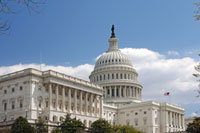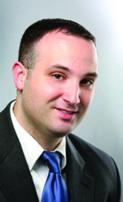 It was only a few months ago when the U.S. device industry's primary concerns with health care reform were reserved to a few, select critical areas of competing legislative proposals. Issues ranging from transparency of industry payments to health care providers, comparative effectiveness research and payment reform were thought to be the proposals most likely to affect the device industry over the course of the next decade. However, in September 2009, the industry was thrown a curve ball when a health care reform proposal generated by the United States Senate Committee on Finance included a $40 billion "fee" on the industry.
It was only a few months ago when the U.S. device industry's primary concerns with health care reform were reserved to a few, select critical areas of competing legislative proposals. Issues ranging from transparency of industry payments to health care providers, comparative effectiveness research and payment reform were thought to be the proposals most likely to affect the device industry over the course of the next decade. However, in September 2009, the industry was thrown a curve ball when a health care reform proposal generated by the United States Senate Committee on Finance included a $40 billion "fee" on the industry.
Senator Max Baucus (D-MT), chairman of the Finance Committee released his bill in September. Most political experts predicted that the Finance Committee bill would be the proposal most similar to what will eventually be passed by Congress. Other Congressional committees of jurisdiction in both the House of Representatives and Senate had released and passed competing versions of a health reform bill. Yet, the Finance Committee remains viewed as being the most critical.
The Tax
Up until the Finance Committee released its health reform legislation in early September, no other version of the various committee proposals included a "fee" on the device industry. In total, there were five versions of health reform legislation being considered.
The House of Representatives, which passed a final version of their bill in November, was the product of three separate committee bills: the Ways and Means Committee, Education and Labor Committee, and the Energy and Commerce Committee. All three of these committees have jurisdiction over some of the provisions of the final bill. In the Senate, the other Committee with jurisdiction is the Health, Education, Labor and Pension (HELP). The HELP Committee passed its bill this summer. None of these committee proposals included a device industry fee.
Not to be outdone, the Finance Committee bill proposed to assess a "fee" on most manufacturers and importers of medical devices. The total amount of revenue it is expected to raise would be $40 billion over 10 years, or approximately $4 billion annually. The fee would be assessed proportionate to market share and on total revenue, not profitability. Most analysts estimate that this would equate to an approximate 3.5 percent assessment on a company's total annual revenue.
The proposed fee would be assessed for all manufacturers of Class III devices and most Class II. Exempted from the fee are Class II products sold at retail with a value of $100 or less and all Class I products. The fee would not be assessed for companies with revenue at $5 million or lower. However, companies with revenues between $5 million and $25 would have a fee assessed on 50 percent of revenue, and any covered company with revenue over $25 million would have the fee assessed on 100 percent of their revenue.
The Finance Committee passed its bill in October by a razor-thin margin.
The House of Representatives liked the prospects of adding additional revenue to help pay for their health reform legislation. When the House passed its final legislation in November, it also included on the industry totaling $20 billion over 10 years. The fee is to be assessed on most device companies regardless of annual revenue, has similar device class exemptions to the Finance Committee bill, and would be implemented starting in 2013. In all, the House device fee will amount to a 2.5 percent annual tax on the industry.
Bad Medicine
The concept of "shared responsibility" has continually been touted by Chairman Baucus and other proponents of the tax as justification for assessing not only the device tax, but also a series of other taxes and cuts that will disproportionately affect a cross section of the health care industry. The underlying premise of the shared responsibility concept is that the overall ends of healthcare reform, increasing health insurance coverage, will ultimately benefit health care industries. Thus, the health care industry must pay their fair share because they will benefit.
A consistent argument used by supporters of the tax is that when there is an increased pool of newly insured beneficiaries, device companies will benefit from having an expanded customer and user base. However, this argument remains shaky at best. Many of the devices that will be affected by the tax are used in the acute care setting, and patients, regardless of insurance, usually will receive the appropriate medical treatment.
For instance, under both the House and Senate proposals, an acute care setting product, such as a defibrillator, would be captured under the definition of the medical device that is taxable. Uninsured people will more likely than not receive some form of appropriate medical care in an emergency medical situation. It will not be the case that more people will be going into cardiac arrest and will need the assistance of a defibrillator. People receive the treatment regardless of insurance status. With this in mind, it’s not likely to affect the purchasing practices of hospitals since many uninsured already receive some form of medical care. This scenario would apply to numerous other medical technologies as well.
The more important underlying impact of the device tax is that it is target on a truly innovative industry producing innovative medical technologies. It is also an industry that is one of the few that has a positive economic growth, even in the most challenging of economic times. At a time when the Federal government is working to promote investment in U.S. industries of the future, it is inconsistent that a tax of this magnitude would be considered on the medical device industry. Currently, the U.S. is the global leader in medical devices and one of the few industries with a net trade surplus. In addition, the U.S. medical technology industry is responsible for nearly 2 million jobs, including some ofthe highest paying manufacturing jobs in the country.
What's Next?
The idea to propose a tax on the medical device industry was nothing more than a "money grab." To make the overall health reform bills more palatable, Congressional leaders and the White House wanted to keep the total cost of the bill under $1 trillion over 10 years. In order to achieve this, legislators have proposed to impose a series of taxes across multiple industries with little rationale thought as to the consequences of such proposals.
The House of Representatives squeaked by a victory in November and passed their bill by only a two vote margin. At the time of this writing, the Senate has yet to release its final bill for debate. All signs indicate that it will still include a tax on the device industry. However, at the end of the day, whatever tax is assessed on the industry will pale in comparison to the greater impact on patient access, jobs and innovation in the medical device industry.
MDMA’s Efforts to Eliminate the Device Tax
The Medical Device Manufacturers Association (MDMA) continues to stand in opposition to the proposed medical device tax, as it stands to harm patient access and innovation by small, innovative medical technology companies. MDMA is continuously reaching out to Congressional leaders to educate them about the devastating impact the tax will have upon the industry, including the impact on jobs, research and development, and the ability of promising new medical technologies to commercialize. MDMA offers its members timely information and analysis about the many moving parts of health care reform and what it means to the industry.
About MDMA
The Medical Device Manufacturers Association (MDMA) is a national trade association based in Washington, DC providing educational and advocacy assistance to innovative and entrepreneurial medical technology companies. Since 1992, MDMA has been the voice for small companies, playing a proactive role in helping to shape policies that impact the medical device innovator. This is accomplished by maintaining relationships with key members of Congress, senior staff at FDA and CMS, and through the grassroots support of their members.

